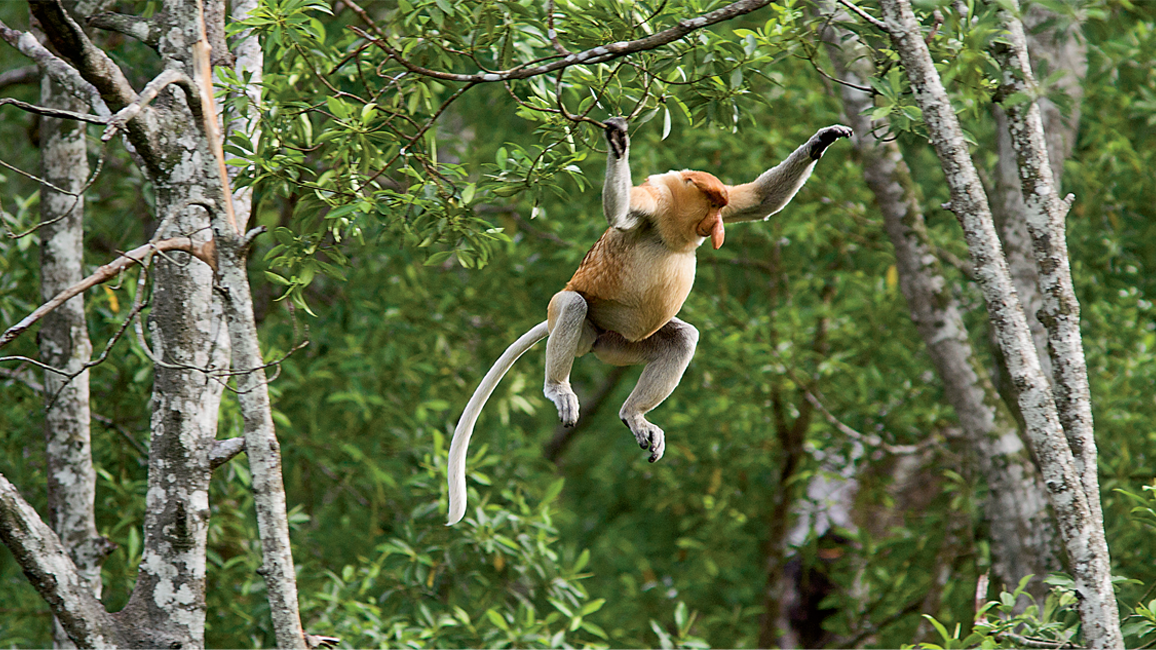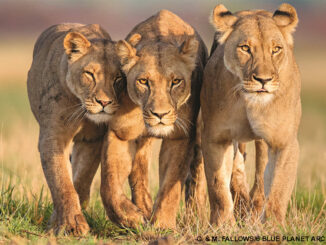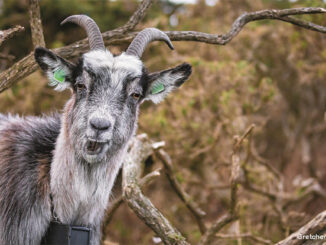
Nosey Monkeys
By Hannah Schardt; photos by Suzi EszterhasSniff out a few things that make these monkeys from Borneo nose-worthy—er, noteworthy.
My, Mr. Monkey, what a big nose you have! But the huge honker on the male proboscis (pro-BAH-sis) monkey in the photo at left isn’t just “all the better to smell you with.” It’s much bigger than any monkey would need just for smelling. So for a long time, people wondered why the proboscis monkey has such a giant, droopy nose. Does it work as a snorkel, letting the monkey breathe while swimming under water? (That’s right—this monkey swims!) Or as an air-conditioner, drawing heat away from the monkey’s body? Who “nose”?
Actually, scientists now think the main reason for that big nose is to impress females. That helps explain why female and baby proboscis monkeys have smaller noses. (Though you can see in the photo at right that even Mama’s nose is nothing to sneeze at!)
The proboscis monkey gets its name from—what else?—its nose. A proboscis is a long, flexible snout. But as you’re about to find out, there’s a lot more to this monkey than its nose.
Monkey Business
Proboscis monkeys live only on an island called Borneo in Southeast Asia (see map). Most of them live in one of two types of groups: a harem (HAIR-um) or a bachelor (BATCH-uh-lur) group. In a harem, one adult male lives with several females and their young. In a bachelor group, a bunch of males live together with no females.
The male monkey in a harem is known as the alpha. He weighs almost 50 pounds— twice as much as an adult female. And he really throws his weight around! If another big male comes too close, the alpha leaps from tree to tree, honking loudly. All the other monkeys scurry up into the treetops in fear.
A young female proboscis monkey may stay with her mom’s group for life. (Some females switch groups at some point during their lives.) But when a male proboscis is about two years old, he leaves Mom to find a bachelor group to live with. He spends a lot of time wrestling with pals and practicing his booming calls—learning to be a tough guy like Dad.
Swim and Snack
Proboscis monkeys are strong swimmers— the best swimmers of all monkeys, in fact. The mangrove forests and swamps where they live are very wet places. Often, when the monkeys leap from tree to tree to cross a river, they miss and make a splash landing. Webbed feet help them swim underwater. They need speed to escape the crocodiles that lurk in there!
Still, proboscis monkeys spend most of their time up in the trees. And that’s where they find their food: seeds, fruits, and leaves—lots of leaves. Leaves are tough to digest, but the stomachs of these monkeys are up to the job. The stomachs are large (just look at their bellies!) and full of helpful bacteria that break down all those leaves into digestible bits.
Proboscis Problem
Proboscis monkeys rely on Borneo’s forests for food and shelter. But people are cutting down the forests to grow palm trees. (The palms’ fruits are used to make oil that is sold all around the world.) That means there are fewer and fewer places where these endangered monkeys can live.
Some people are trying to help. They are buying up forests where proboscis monkeys live and making them off limits for farming and other human activities. And that’s good news for tree-loving monkeys! Now do you see what makes a proboscis monkey so interesting? The reasons are as plain as the nose on its face!



















